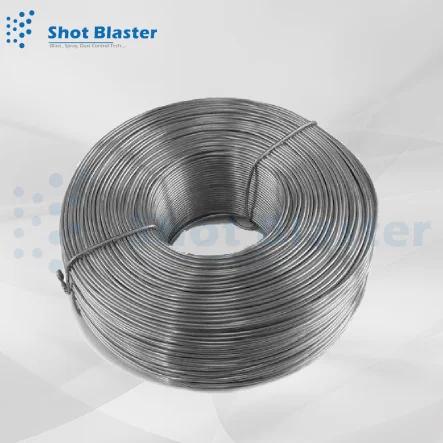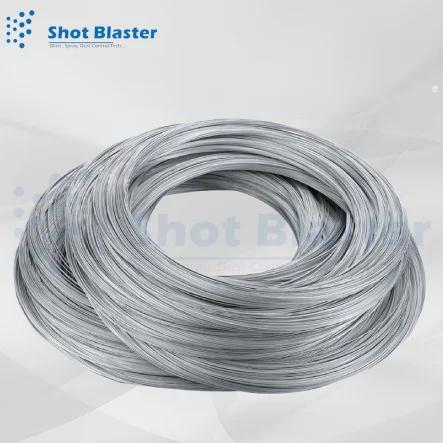What Is Thermal Spray Metalizing Wire?
The thermal spray metalizing wire is used in a thermal spray gun to provide a protective coating layer on the substrate. Metalizing wire coatings are provided to increase the life of substrate use in different applications and provide protection from rust, oxidation to the substrate used in sea and open environment areas. The metalizing wire utilized in the thermal spray guns for the coating method. Coating provides over the substrate with a distinct methodology. Thermal spraying is finished to extend the lifetime of the substrate and forestall it from corrosion in even the toughest condition.
The choice of metalizing wires within the thermal spray relies on the applying of the substrate on that coating to be done. Metalizing wires area unit utilized in pure type also as in alloy type conjointly. Before metalizing wires coating for surface roughness sand blasting machine, shot blasting machine, grit blasting machine, sandblasting hopper is used to prepare the surface.
In blasting different abrasive like aluminium oxide, glass beads, copper slag, steel grit, steel shots, and abrasive garnet are used as per requirement.
Types of Thermal Spray Metalizing Wire
Zinc Metalizing Wire
Zinc metalizing wire is a gift in an exceedingly kind of diameter and principally employed in little, voids, and uncoated areas that don't seem to be pronto accessible. atomic number 30 wire coating has a lot of resistance in water and less in water. The pH scale price of atomic number 30 wire is generally six to twelve. atomic number 30 coating has poor resistance in any water higher than sixty degrees uranologist.
Atomic number 30 wires coating has poor resistance to most organic and inorganic acids. Atomic number 30 is generally used as a primer on surfaces to create electrically semi-conductive surfaces on glass and ceramics. Atomic number 30 wire conjointly employed in alloy type depends upon the applying.
Aluminium Metalizing Wire
Aluminium metalizing wire is employed within the coating method and drawn to a spread of diameter to be used during a flame applicator and arc applicator system. In a flame spray gun oxygen and acetylene gas is used with compressed air to metal wire and an arc spray gun is used with a power source to the metal metalizing wire.
The metal wire has helpful characteristics that embody resistance to the atmosphere, chemical, and warmth corrosion. Metal wires square measure smart electrical conductors. Metal wire coating tends to make an associate chemical compound film that protects it from additional attack.
Aluminum wires coating used for cathodic corrosion protection in atmospherically and salt/freshwater immersion, with application areas like oil purification instrumentation, chemical process instrumentation, and boat bottom interiors exposed to bilge water, and alternative similar kinds of exposure. It will increase the lifetime of the substrate by 15-50 years while not maintenance.
Babbitt Metalizing Wire
Babbitt metalizing wire is employed for coating this material will be tin or lead, antimony, or copper. Babbitt wire has a laborious and soft composition and that provides excellent low wear and friction resistance. Babbitt wire is employed for the protection of the food tank and produces an awfully dense coating layer of zero.25 to 0.65 metric linear unit over the substrate. Babbitt wire freezing point is 695 degrees Anders Celsius.
Babbitt wires coating metals square measure employed in the high duty and high-speed bearings. Babbitt wire additionally is employed in alloy forms also to supply coating employing a thermal applier or spray.
Molybdenum Metalizing Wire
Molybdenum metalizing wire is employed for industrial and high load vehicles as a result of its ability to resist high mechanical masses. A skinny layer of metal wires area unit sprayed on vehicle and principally used on slippery elements in machine and vehicle too.
Shift forks, measuring device rings, piston rings, synchronizing assemblies, and different vehicle and machine elements area unit coated and guarded by metal wire victimization thermal spray. Metal wire conjointly utilized in the shape of alloy to produce protective coating supported application.
Nickel Metalizing Wire
Nickel metalizing wire is used to protect the substrate surface from corrosion. A nickel wire is also provided very high corrosion resistance in the water, marine, and melts. Nickel wire coating is more adhered to the substrate and very dense compared to other wire sprayed coatings.
Nickel wire coating is also used in chemical application substrate and chloride cleaning solutions. In most application areas nickel used in form of alloy to supply a protective layer over the substrate.
Copper Metalizing Wire
The copper metalizing wire is a corrosion-resistant material in a non-oxidizing environment; generally used to provide resistance on the substrate to neutral atmospheric conditions and seawater environments. Copper wire has good electrical and thermal conductivity.
Copper wires are used in the thermal spray process for restoration particularly on copper alloy substrate and in electrical applications where a coating is required with good conductivity.
Tin Metalizing Wire
Tin metalizing wires are used for the protection of containers employed in food processing/ storage and for the repair of glass-lined tanks. Tin wire produces terribly dense coatings from zero.25 to 0.65 mm (0.01in-0.025in) thick that has corrosion protection to the substrate from varied solvents. it's nobler for metals and alloys than steel within the electromotive series. Tin wires area unit used as a bond coat for prime freezing point materials like Monel (nickel-copper), nickel, bronze, and chrome steel.
Bronze Metalizing Wire
The bronze metalizing wire used to provide or supply a protective coating to the substrate. Aluminum bronze wire-like Sprabronze AA and Sprabronze AB are used for wire feedstock thermal spray processes. Sprabronze S is a brass alloy bronze and Sprbronze TM is a Tobin-type bronze. Bronze wire coatings are machinable and these wire coatings are used to achieve excellent finishing.
Bronze wire and its alloy offer corrosion resistance especially in neutral atmospheres and water environments. Bronze wire coating is recommended for soft bearing applications and machine element repair.







